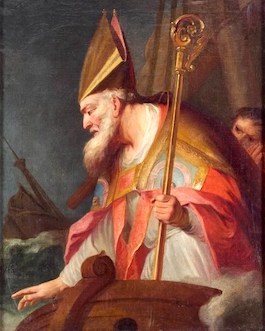St. Nicholas or Santa Claus?
- SEAN FITZPATRICK
Though many parents reject Santa Claus as a fib, Santa Claus is true because he is a symbol of truth.
 The Christian battle for Christmas is an uphill one — which is the very reason why it is one worth fighting. "Season's Greetings" and "Happy Holidays" are the prophylactic, politically-correct slogans that smilingly strive to keep Christ and all His kith and kin well out of Christmas. Commercialism supplants Catholicism. The mall replaces the Mass. But Santa Claus does not depose St. Nicholas. For even as the world wrests Clement C. Moore's immortal poem to the title "The Night Before Christmas," his true title, now often forgotten or forgone, is, "A Visit from St. Nicholas."
The Christian battle for Christmas is an uphill one — which is the very reason why it is one worth fighting. "Season's Greetings" and "Happy Holidays" are the prophylactic, politically-correct slogans that smilingly strive to keep Christ and all His kith and kin well out of Christmas. Commercialism supplants Catholicism. The mall replaces the Mass. But Santa Claus does not depose St. Nicholas. For even as the world wrests Clement C. Moore's immortal poem to the title "The Night Before Christmas," his true title, now often forgotten or forgone, is, "A Visit from St. Nicholas."
Though many parents reject Santa Claus as a fib, Santa Claus is true because he is a symbol of truth. Santa Claus and the myriad traditions surrounding the cultus of St. Nicholas represents those unseen powers that are a part of life — the most important part of life. Unfortunately, it is not unusual for Catholic parents not to "do" Santa Claus with their children because of the earthward shift in the paradigms of the modern Christmas season. Those things that secular society parodies, however, are very often the very things worth protecting. The world has sold Santa Claus into the slavery of a Christ-less Christmas. Santa Claus's image has suffered as a result, but only because he was deemed worthy of assault.
Plato used to tell of the existence of two worlds — one of shadows and the other, as George MacDonald called it, "the land from whence the shadows fall." The Incarnation marked the elimination of a primary boundary between the shadows and their reality, between the natural and the supernatural, filling up the gulf between the ordinary and the extraordinary. This is clear in the joyful juxtaposition of angels and shepherds, peasants and kings, man and God — and Dr. Moore calling the sainted Bishop of Myra "a right jolly old elf." And so he is, despite the decision of many to deny it, even to their own children.
In keeping with the Mystery of Christmas, Christmas folklore delves into those mysteries that surround us — most commonly depicted as fairies, ghosts, and elves. (This is not to say that fairies, ghosts, and elves are not real — there is simply some doubt and disputation as to what their exact natures are.) Such creatures and their traditions usually and casually present other-worldly beings as part of the household and everyday life. It is at Christmastime, though, that their presence is more poignant as they give strong reflection to the fact that the supernatural is not above mingling with the natural — a fact confirmed by every saint — a truth that is strange.
Truth that is strange is a good segue to the saint known as Santa Claus. The strange truth about this mountain of a man is that not much is known about him. Little remains concerning this fourth century bishop, but his legends are large — larger than his life even. For one with such scant history, it is wondrous how his stories abound, like so many merry mysteries. St. Nicholas is one of those special saints whose actual deeds are overshadowed by the tall tales those deeds inspired, whose zeal and piety are remembered only in the language of miracles and wonders — miracles and wonders that may or may not be true but are reflective of the truth.
The fact is, what is most important about St. Nicholas is not the date he was supposedly born in a coastal town of Asia Minor; it is not how he allegedly suffered under the Diocletian persecution; it is not the theory of his ordination; it is not the records that suggest when he became Bishop of Myra. What is most important about St. Nicholas are not the facts of his existence at all, but rather the fact that he existed at all — an existence that was real enough to become the stuff of dreams.
No one can deny the impact of the fact of St. Nicholas. For all his heresy, Arius could attest truly to the bare fact of Nicholas — especially Nicholas' bare fist when it struck him like a thunderbolt at the Council of Nicaea and sent him sprawling at the feet of the Fathers. Nicholas was man enough to become a myth, and solid enough to float and blast through the ages like a hurricane. We will never know much about Nicholas, but we do know of his existence, and that is enough for us to believe that he exists to this day.
Nicholas was man enough to become a myth, and solid enough to float and blast through the ages like a hurricane.
Whether factual or false, Nicholas tossing bags of gold in at poor men's windows to save their daughters from debasing professions is an indispensable and immortal treasure of holy lore. St. Nicholas' generosity was so great it has given throughout the centuries: gifts of pious yarns of impossible charity, of resurrecting pickled boys from murderous innkeepers' brine barrels, and saving sailors on stormy seas, and plucking captives off the decks of pirate ships; gifts of indefatigable mirth and might, of secret presences that bring and breathe the benevolence of God down the chimney.
The miracle of Christmastide is conjoined to the innocent tradition and truth of this "right jolly old elf," of jolly old St. Nicholas, who comes with gifts to celebrate and signify the Miraculous Gift of Christmas. And it is a miracle that should be guarded and cherished by every adult who was a child, and certainly by every parent who has a child. Fathers and mothers are really and truly invited to participate in the secret of the saint who comes to eradicate Want and enthrone Abundance on the night before Christmas.
St. Nicholas, the patron of youth, forms a necessary alliance with parents to minister to his charges with due affection. Though a merry consortium it is, it is yet a holy one. The events outlined in the beloved poem "A Visit from St. Nicholas" bear the tone and order of a religious ceremony. Silence. Smoke. Gifts. Nods. Communion between the material and immaterial worlds.
And such communions are simply not falsehoods, even though they are fantastic. After all, no father thinks he is lying when, after a prayer to St. Joseph before a difficult cut with the miter saw, he says to his assisting son, "St. Joseph really came through for us there." No mother thinks she is lying when, upon missing a child's shoe she recites the jingling prayer to St. Anthony as she looks under the sofa and, finding the shoe, says, "St. Anthony never fails us." No parent thinks they are lying when their child has a near accident and they say, "Your Guardian Angel really was watching out for you today."
These are not lies. They are words of faith for very true things.
If these are not lies, then why do some think it a lie when we tell our children that St. Nicholas, the patron saint of children, played a part in the holy day for children, especially if the stockings were filled with a simple prayer for blessing from that jolly old saint — or elf, as it may be the terms are more or less interchangeable. These are not lies. They are words of faith for very true things.
It falls to mothers and fathers of faith to revive St. Nicholas, allowing him to wink and twist his head — giving us to know we have nothing to dread. This is the work and the place of holy and whimsical lore, creations and cooperations that mingle heaven with earth. Man is not a disembodied soul and requires bodily things to draw him to the divine — he needs incarnations just as he needed the Incarnation.
There is more to the dogma of Christmas than the Gospel. There are symbols and sacramentals that proceed from this source, and Santa Claus is one of them. There are mysteries at work in the world that subsist in the Mystery of the Word made Flesh. Keeping Christmas well, therefore, should include things strange and wonderful — things like elves, fairies, ghosts, and, yes, Virginia, Santa Claus; things that reflect and recall that time when heavenly nature took on earthly nature.
The world is full of mystery — things that we do not understand, but still believe in. St. Nicholas does indeed come on the night before Christmas, and he holds a special and strange partnership with parents. He comes and fills the stockings hung by the chimney with care, but he uses the hands of husbands and wives. Santa Claus is real — believe it — but like a great many things we believe, he works invisibly through visible things.
 This is J. Fraser Field, Founder of CERC. I hope you appreciated this piece. We curate these articles especially for believers like you.
This is J. Fraser Field, Founder of CERC. I hope you appreciated this piece. We curate these articles especially for believers like you.
Please show your appreciation by making a $3 donation. CERC is entirely reader supported.

Acknowledgement
Sean Fitzpatrick. "St. Nicholas or Santa Claus?" Catholic World Report (December 5, 2021).
Reprinted with permission of Catholic World Report.
The Author
 Sean Fitzpatrick serves on the faculty of Gregory the Great Academy in Elmhurst, Pennsylvania. He teaches Literature, Mythology, and Humanities. He lives in Scranton with his wife, Sophie, and their six children.
Sean Fitzpatrick serves on the faculty of Gregory the Great Academy in Elmhurst, Pennsylvania. He teaches Literature, Mythology, and Humanities. He lives in Scranton with his wife, Sophie, and their six children.


